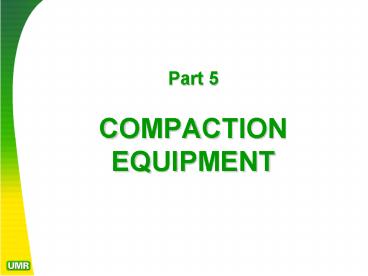Part 5 COMPACTION EQUIPMENT - PowerPoint PPT Presentation
1 / 13
Title:
Part 5 COMPACTION EQUIPMENT
Description:
This shows the Allis Chalmers roller, which introduced replaceable 'hammerhead ... 50 ton rubber tired roller being used to compact an damaged airport runway. ... – PowerPoint PPT presentation
Number of Views:4100
Avg rating:5.0/5.0
Title: Part 5 COMPACTION EQUIPMENT
1
Part 5COMPACTIONEQUIPMENT
2
- The sheepsfoot roller has evolved into a wide
variety of forms. This shows the Allis Chalmers
roller, which introduced replaceable hammerhead
tips in the late 1930s, during construction of
the San Gabriel Dam
3
- Spike rollers are a sheepsfoot variant that can
be employed to help break up and disaggregate
soft or fissile bedrock materials, increasing the
bulk density of the fill mixture
4
SHEEPSFOOT ROLLERS
- Most sand and water-filled sheepsfoot rollers are
capable of delivering 250 psi contact pressure,
if the spike contact area is between 5 and 8
square inches. The spikes compact a zone 2 to 8
inches beneath their tips.
5
- Sheepsfoot rollers walk out of the soil as it
becomes densified, leaving the uppermost 1 to 2
inches uncompacted - For this reason it is important that cohesive
soils be scarified prior to compaction (difficult
if scrappers have been running over everything)
6
PAD ROLLERS
- Self-propelled tamping or pad rollers are capable
of delivering 5 to 75 psi contact pressures.
They are well suited to most soil mixtures and
may employ vibration (2500 to 4500 Hz) for
compacting cohesionless (sandy) materials.
7
SELF-PROPELED ROLLERS
- Self-propelled compactors like these CAT 835s can
be fitted with different kinds of rollers. The
machine at left has a pad roller while the one at
right employs actual sheepsfoot roller pins.
8
- 50 ton rubber tired roller being used to compact
an damaged airport runway. Note box segments,
which are semi-articulated.
9
COMPACTIVE EFFORT
- Rubber tired (pneumatic) rollers exert a
compactive effort equal to the air pressure in
their tires (35 to 55 psi). Large towed
pneumatic compactors (gt 50 tons) can exert 100
psi contact pressure.
10
- Ramex hand-operated compacter, used mostly in
trenches and difficult access areas. Hand
operated compactors such as this and smaller
Whackers and pogo-sticks generally exert
between 8 and 18 psi contact pressures, well
below mechanized equipment
11
- Plate compactors can be attached to tracked
excavators to provide mechanical compaction of
trench backfill, mostly for buried utilities.
These trenches are not usually compacted in 6 to
8 inch lifts, so can settle noticeably.
12
CONTACT PRESSURES
- Contact pressure/Input energy for various types
of compactors. Note that track-walking fill with
dozers is not an adequate means of compaction.
13
- TEST STRIPS
- Test strips are useful to determine which type of
compactor and how many passes will be necessary
to achieve the desired compaction - In this example, P is pneumatic tire roller T is
a tamping foot, or pad roller and V is a
vibrating drum roller - The example at left is for a granular soil
mixture which benefit from vibratory compaction































